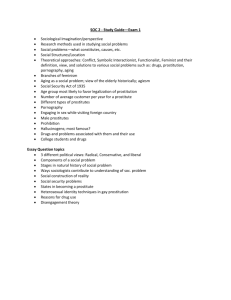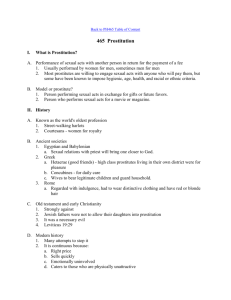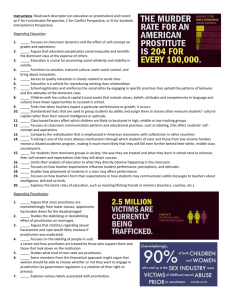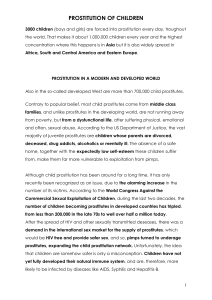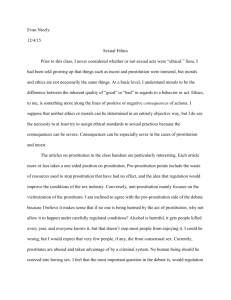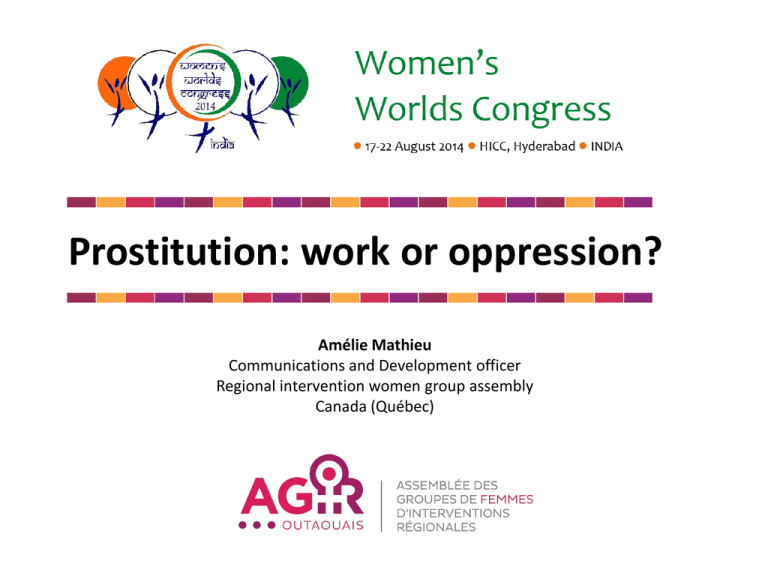
Prostitution: work or oppression?
Amélie Mathieu
Communications and Development officer
Regional intervention women group assembly
Canada (Québec)
Menu
PROSTITUTION: WORK OR OPPRESSION?
• Canadian History of prostitution
• Bill C-36
• Pro-sex workers’ reactions
• Abolitionists
• CONCLUSION
Two positions, same goal
Pro-sex workers
• Define prostitution as a job, and
therefore wish to protect
prostitutes by invalidating any law
that would stop them from
working, and by providing extra
supervision for the industry.
• Australia (1980)
• Germany (2002)
• Netherlands (2000)
• New-Zeeland (2003)
Abolitionists
• See prostitution as sexual
exploitation, and opt to promote
sex-trade workers’ safety by
penalizing clients and pimps
whom they identify as both a
threat, and the source of human
trafficking success.
• Sweden (1999)
• Norway (2009)
• Island (2009)
• France (2013).
Even though these two opposite views share the common goal of protecting
sex workers, they contemplate different legal means for this achievement.
Canadian History of prostitution
• 2014: The government submitted Bill C-36
regarding prostitution.
• 2013: The Supreme Court of Canada
decriminalized prostitution, and gave the
government no more than one year to adopt a
new legislative model.
Canadian History of prostitution
• 1892: Prostitution was mentioned for the first time in the Criminal
Code.
• 1985: Bill C-49 modernized the Criminal Code’s disposition towards
soliciting.
"Every person who in a public place or in any place open to public
view communicates or attempts to communicate with any person
for the purpose of engaging in prostitution or of obtaining the
sexual services of a prostitute is guilty of an offence punishable on
summary conviction. "
• 1989: The Government adopted it in order to "solve the problem of
nuisance, not the prostitution problem in whole“
Federal-Provincial-Territorial Smith Working Group on Prostitution
Bill C-36
• June 4, 2014: Bill C-36 "Protection of Communities and
Exploited Persons Act"
• Based upon the abolitionist legislative model
–
–
–
–
Sweden
Norway
Island
France
• Penalises clients and pimps without penalising sextrade workers.
• Particularity of the Canadian model: does not exclude
the possibility of criminalizing prostitutes who solicit,
and offer sexual services.
Pro-sex workers’ reactions
Bill C-36…
• Goes against the Charter of Rights and Freedoms
• Puts prostitutes at risk
• Penalising clients and pimps, and forbidding the
advertisement of services will affect prostitutes
way more than it may help them in their work
• Reduces the consumer demand for sexual
services, a 40% decrease of clients
Pro-sex workers’ reactions
• The purpose of banning third parties from capitalising on
prostitution is to abolish sexual service businesses online, escort
services, massage parlours, and strip clubs that also provide sexual
services. This will force prostitutes who no longer have access to
this type of supervision, to find clients on their own, and to work in
more clandestine places, closer to criminals
• Prohibition of advertising services online or in other publications
will make it even harder for prostitutes to find clients
• Prostitutes risk being incarcerated if they get caught advertising, or
soliciting near schools, day-care centres, parks, or churches
– This criminal infraction is special alteration of the Canadian
Government to the traditional Nordic model. Normally, this type of
legislative framework does not penalise prostitutes in any way.
Pro-sex workers’ reactions
• Pro-sex workers ask for a legal framework that would allow
prostitutes to work in the safest possible conditions, while
also limiting inconvenience for the rest of society, and
fighting criminal networks that exploit minors, vulnerable
women, and out-of-status immigrants.
November 30, 2013- Sex-trade workers in France protest against the
new law penalizing clients
Abolitionists
Bill C-36…
• Is a weapon against sexual exploitation
• Fights the black market at its source by penalising
clients and pimps, and prohibiting advertisement or
solicitation of sexual services
• Prostitution = an "organized worldwide system,
governed by pimps that recruits, buys and sells women
and girls forced to be prostitutes by misery, violence or
illusion, as they have no other option.“
Abolitionists
Statistics show the necessity of fighting human trafficking
• Investigations carried out in several countries reveal that
89% or more of prostitute women wish to leave
prostitution, and none of them would like their own
daughter to do this type of "work.
• The human trafficking market’s profit in my region,
Outaouais, alone is of more than 25 million dollars and 90%
of human trafficking victims in Ottawa and Gatineau are
Canadians.
Abolitionists
• The Stockholm prostitution centre declared that
60% of its clientele quit prostitution after the
abolitionist legislative model was established.
• Many admitted that the law motivated them to
find help and quit prostitution.
June 13, 2013 – Abolitionists’ protest in front of the Supreme Court
of Canada at the beginning of Bedford hearings
CONCLUSION
• Raising our governments’ awareness for the issue
of prostitution
• Investing in police training and in organizations
that work with survivor prostitutes
• Tackling poverty, violence and our capitalist
society's engine
Regional intervention
women group assembly
Thank you!
Together for Equality
www.agir-outaouais.ca

